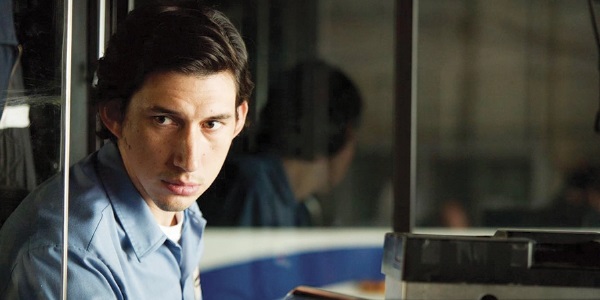PATERSON: Art As A Process Of Possibility

Daniel is a writer based in Sheffield, UK. He has…
Jim Jarmusch is a self-proclaimed dilettante, an avowed amateur constantly relearning the form, guided by an endless spirit of curiosity. This omnivorous approach is reflected in Jarmusch‘s work, which encompasses skewed takes on genre like the offbeat prison break drama Down by Law, the hallucinogenic western Dead Man, the quirky hit-man koan Ghost Dog: The Way of the Samurai, and the luscious vampire love story Only Lovers Left Alive. Jarmusch blends a humanistic impulse with a referential streak, exhibiting the magpie aesthetic long before Tarantino turned it into an article of faith. His films are a series of strange and inspired diversions from a precarious path.
Coming up in New York’s ‘no wave’ scene and revering underground pioneers like Jack Smith and Amos Poe, Jarmusch is one of the last great independents, charting his own course while so many of his peers have been lured by the blandishments of the mainstream. But in a sign of the diminishing space for genuinely independent voices, Jarmusch has reached out to Amazon Studios to distribute Paterson and his documentary on The Stooges, Gimme Danger – Amazon is making a play for credibility by co-distributing the likes of Creative Control, Love & Friendship, Wiener-Dog and Manchester by the Sea.

Paterson refers to both the film’s location and its central character (Adam Driver), a bus driver who writes poetry in the vein of the New York School. Paterson refuses to let anyone see his poems, despite the encouragement of his wife, Laura (Golshifteh Farahani), who seems unsure whether she wants to be a painter, a country singer or a cupcake entrepreneur. Paterson’s poems remain in his ‘secret notebook.’ The film follows a week in the life of Paterson as he goes to work; listens to his passengers talking; sits by the Great Falls of the Passaic River and composes poetry; walks his pet bulldog and stops off at a bar. If this précis sounds underwhelming, it conveys little of what Paterson is actually about.
A Collection of Impressions
Structurally, conceptually and spiritually, Paterson is informed by the poetry of William Carlos Williams, a Paterson native who worked as a doctor while penning poems like “This Is Just to Say” and “The Red Wheelbarrow.” Poetry is one of Jarmusch‘s many passions, having studied under poets Kenneth Koch and David Shapiro, and he references poets like Blake and Frost in his work. Paterson has the flow of a poem, imbued with the spirit of Frank O’ Hara‘s philosophy of ‘personism’ and Williams‘ belief that there is ‘no ideas but in things.’ It is a collection of impressions which, in their assembly, constitute a version of a life.

Paterson has a transcendent banality that only a master filmmaker is capable of achieving, magnifying the everyday until it assumes its own heroism and grandeur. The week in which we observe Paterson’s life is fraught with its own small pitfalls and insights. Jarmusch offers a master-class in visual literacy, circumventing clumsy exposition by offering a series of visual clues which point to a character’s past and inner life. Works by Herman Melville and David Foster Wallace on Paterson’s bookshelf, for instance, hint at a darker undercurrent to the film’s harmonious surface, of the artist’s struggle amidst the demands of the quotidian. This sense of inner tumult is heightened by Carter Logan‘s stirring ambient score.
Capturing the Duality
Driver is in mesmerising form as this receptor of the everyday. As much as it is laced with laconic humour, there is something oddly enigmatic about Driver‘s performance which captures the duality of ‘a bus driver who likes Emily Dickinson.’ Driver gets under the skin of Paterson’s fundamental ambivalence, conveying slight variances in his outer ease which betray a battle for a solid sense of self-definition. Long after the flush of fame has receded, it is for performances like this that Driver will be remembered.
The characterization of Laura veers towards the ‘manic pixie dream girl’ model at times, but the winsome exuberance of Farahani‘s performance leavens some of this and prevents it from becoming irksome. In the supporting roles, Barry Shabaka Henley is fantastic as the hangdog landlord of Paterson’s local bar, and Rizwan Manji shines as a harassed fellow driver who shares an ever-lengthening litany of woes with Paterson.

Jarmusch‘s work has always had an eye for the marginal, and one of Paterson‘s most striking elements is its ethnic diversity. Paterson has much in common with the work of Aki Kaurisamäki; not merely in Frederick Elmes‘ pictorial cinematography – which is as crystalline and crisp as the poetry – but in its presentation of a low-key utopia in which people co-exist in a kind of benign torpor, the wicked world intervening in glimpses.
The Verdict
The world Paterson sees through the window of his bus is one of quiet wonder. Jarmusch shows the tenderness between Paterson and Laura without an overt sexual dimension, which serves to intensify the small signs of everyday affection they display. The central relationship in Paterson is a testament to love’s fortifying gift, offering a more realistic take on romance within which the workaday world serves as an intermediary.
Paterson finds Jarmusch in a more mature, meditative frame of mind; it shares much with David Lynch‘s The Straight Story in being a gentle variant, but one entirely in keeping with the larger body of work. Paterson explores the sides of ourselves we keep hidden from the world, the struggle to catch snippets of consciousness in which the artist is engaged, and the gratitude for the miniscule moments which serve to reify this state of abstraction.
It may not seem to have much in common with Gimme Danger, but Paterson depicts a working-class artist forging his own path, pursuing expression for its own sake and revelling in the freedom of a blissful obscurity. It is a quietly majestic paean to the life of the mind; to the perishability of everything; to ‘words written on water’; to art as a process of possibility.
What are your thoughts on Paterson‘s depiction of the creative process?
Paterson was released in the UK on November 25th and the US on December 28th. Find international release dates here.
Does content like this matter to you?
Become a Member and support film journalism. Unlock access to all of Film Inquiry`s great articles. Join a community of like-minded readers who are passionate about cinema - get access to our private members Network, give back to independent filmmakers, and more.
Daniel is a writer based in Sheffield, UK. He has contributed to sites like HeyUGuys, The Shiznit, Sabotage Times, Roobla, Column F and The State of the Arts. He has a propensity to wax lyrical about Film Noir on the slightest provocation, which makes him a hit at parties. The detritus of his creative outpourings can be found at waxbarricades.wordpress.com.













